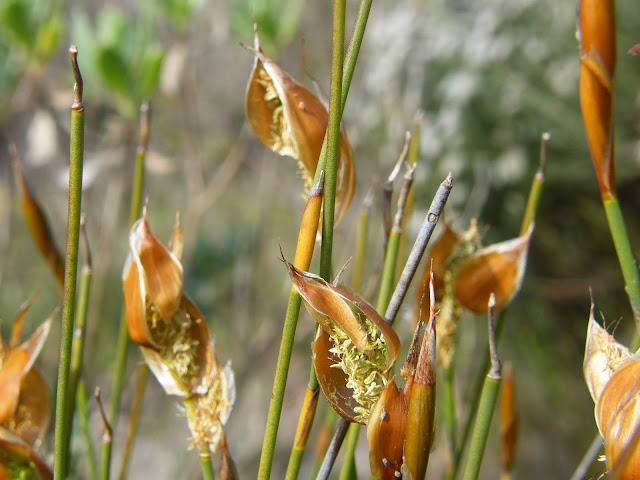 |
| Scientific name: Willdenowia teres Family: Restionaceae |
The fynbos consists of restios instead of grass. In contrast to most other flowering plants, restios do not have leaves. When in flower, you can tell the male from the female plant. The stems are called culms. The culms are the only green part, which is why they are responsible for photosynthesis.
Plant Description
Willdenowia teres are a tall rhizomatous plant that grows 0,3 - 1m high. It has smooth culms with sheaths loosely wrapped around the culms. Usually, culms are smooth and sparsely branched, while sheaths enclose them loosely, and the upper third is membranous and decaying in older specimens. It is dioecious, meaning the inflorescences appear on different plants. The fruit is a smooth, dark brown nut, sparsely pitted with an obvious fleshy green structure attached to the seed. Flowering occurs from July to October. Female plants produce the seeds. From November to June the seeds are dispersed. The ants disperse the seeds.
Growing and maintenance of Willdenowia teres
Plants grow on sandy flats in full sun. It is suitable for various purposes, such as windbreakers, hedges, and pioneer plants. Grow in water-wise gardens and plant in masses.
In the wild, seeds germinate immediately after the onset of the winter rains. There is a short window of about four months for the seeds to establish themselves before the harsh summer.
Propagate from seeds:
Sow seeds in late autumn from April - May.
Fill a seedling tray with milled bark and sand.
Sow seeds in a seedling tray filled with well-draining soil.
Cover seeds lightly with sand.
Water seeds with smoke treated water to stimulate germination.
Place seed in a light-filled room until the seeds germinate.
